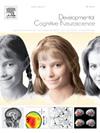Sex-specific relationships between gray matter volume and executive function in young children with and without prenatal alcohol exposure
IF 4.9
2区 医学
Q1 NEUROSCIENCES
引用次数: 0
Abstract
Sex differences in brain volume are well established across ages however, limited research has investigated if sex differences in brain structure associate with early cognitive outcomes. Moreover, associations among sex, brain structure, and cognition in individuals with prenatal alcohol exposure (PAE), the most common known cause of developmental delay in North America, are unclear. Here, we investigated associations between executive function (measured by the BRIEF or BRIEF-P Global Executive Composite (GEC) and the Statue subtest of the NEPSY-II) and volumes of 36 gray matter regions in a longitudinal MRI sample of 169 young children (NPAE=37; 534 total scans) aged 2–8 years. We found significant three-way interactions between sex, alcohol exposure, and executive function in 22 regions for GEC and 6 regions for Statue. Unexposed males showed negative executive function-volume associations, whereas males with PAE showed opposite associations. Unexposed females showed strong positive executive function-volume associations whereas females with PAE showed weak positive associations. We also evaluated reduced models in regions without significant 3-way interactions and found significant two-way interactions of sex and executive function for the GEC in three regions, and for the Statue in 22 regions. Males showed a negative executive function-volume relationship whereas females showed a positive relationship, regardless of exposure status. Our results suggest that males with PAE and unexposed females show relatively more mature volume-executive function relationships than females with PAE and unexposed males. This study highlights the importance of considering sex in investigations of brain and cognition, especially in populations with PAE.
有或没有产前酒精暴露的幼儿的灰质体积和执行功能之间的性别特异性关系
脑容量的性别差异在各个年龄段都很明显,然而,有限的研究调查了大脑结构的性别差异是否与早期认知结果有关。此外,性别、大脑结构和产前酒精暴露(PAE)个体的认知之间的关系(PAE是北美已知的最常见的发育迟缓原因)尚不清楚。在这里,我们研究了执行功能(通过BRIEF或BRIEF- p Global executive Composite (GEC)和nepsyi - ii的Statue子测试测量)与169名2-8岁幼儿(NPAE=37; 534次总扫描)的纵向MRI样本中36个灰质区域的体积之间的关系。我们发现在22个GEC区域和6个Statue区域中,性别、酒精暴露和执行功能之间存在显著的三方相互作用。未暴露的雄性表现出负的执行功能-体积关联,而患有PAE的雄性表现出相反的关联。未暴露的雌性表现出强烈的正相关,而PAE雌性表现出微弱的正相关。我们还评估了没有显著双向交互的区域的简化模型,发现三个区域的GEC和22个区域的Statue的性别和执行功能存在显著的双向交互。无论暴露状态如何,男性的执行功能与容积呈负相关,而女性的执行功能与容积呈正相关。我们的研究结果表明,与PAE和未暴露的雄性相比,PAE和未暴露的雌性表现出相对更成熟的体积-执行功能关系。这项研究强调了在大脑和认知研究中考虑性别的重要性,特别是在PAE人群中。
本文章由计算机程序翻译,如有差异,请以英文原文为准。
求助全文
约1分钟内获得全文
求助全文
来源期刊

Developmental Cognitive Neuroscience
NEUROSCIENCES-
CiteScore
7.60
自引率
10.60%
发文量
124
审稿时长
6-12 weeks
期刊介绍:
The journal publishes theoretical and research papers on cognitive brain development, from infancy through childhood and adolescence and into adulthood. It covers neurocognitive development and neurocognitive processing in both typical and atypical development, including social and affective aspects. Appropriate methodologies for the journal include, but are not limited to, functional neuroimaging (fMRI and MEG), electrophysiology (EEG and ERP), NIRS and transcranial magnetic stimulation, as well as other basic neuroscience approaches using cellular and animal models that directly address cognitive brain development, patient studies, case studies, post-mortem studies and pharmacological studies.
 求助内容:
求助内容: 应助结果提醒方式:
应助结果提醒方式:


